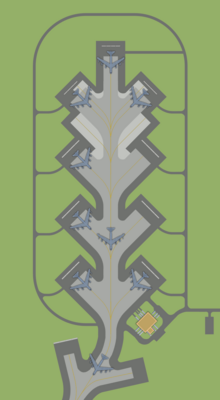
A mole hole, officially designated the Readiness Crew Building (RCB),[1] is a type of structure built by the United States Air Force at former Strategic Air Command (SAC) bases around the country during the 1950s and 1960s. The diagram to the right indicates the positioning of an RCB at the former Glasgow Air Force Base, Montana. Nearly identical facilities were constructed at many other SAC bases of the Cold War period, such as Barksdale Air Force Base, Louisiana; Fairchild Air Force Base, Washington; McConnell Air Force Base, Kansas; Pease Air Force Base, New Hampshire; McCoy Air Force Base, Florida and March Air Force Base, California or bases where SAC was a tenant such as Robins Air Force Base, Georgia and Mather Air Force Base, California.
RCBs were located adjacent to an Alert Ramp, also called a "Christmas Tree", where Ready Alert bomber and aerial refueling (also known as "tanker") aircraft were parked. These aircraft were initially Boeing B-47 Stratojet aircraft armed with nuclear weapons, augmented by Boeing KC-97 Stratofreighter aerial refueling aircraft. As SAC introduced newer bomber and aerial tanker aircraft into its inventory, the B-47 and KC-97 were later superseded by Boeing B-52 Stratofortress, Convair B-58 Hustler, General Dynamics FB-111 or Rockwell B-1 Lancer bombers, augmented by Boeing KC-135 Stratotanker or McDonnell Douglas KC-10 Extender aerial refueling aircraft.
- ^ "Loring Air Force Base, Alert Area" (PDF). Historic American Engineering Record. Loring Air Force Base: Library of Congress. Retrieved 21 October 2012.